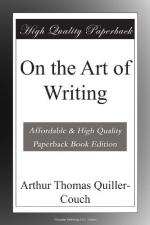This difficulty, inherent in navigation as a subject for the Epic Muse, has, I think, been very shrewdly detected and hit off in a parody of Mr Noyes’ poem by a young friend of mine, Mr Wilfred Blair:—
Meanwhile the wind had
changed, and Francis Drake
Put down the helm and
drove against the seas—
Once more the wind changed,
and the simple seaman,
Full fraught with weather
wisdom, once again
Put down the helm and
so drove on—et cetera.
Now Homer actually has performed this feat which we declare to be next to impossible. He actually does convey Odysseus from Troy to Ithaca, by a ten years’ voyage too; he actually has narrated that voyage to us in plain straightforward words; and, what is more, he actually has made a superb epic of it. Yes, but when you come to dissect the Odyssey, what amazing artifice is found under that apparently straightforward tale!—eight years of the ten sliced out, to start with, and magnificently presented to Circe
Where that Aeaean isle forgets the main
—and (one may add), so forgetting, avoids the technical difficulties connected therewith.
Note the space given to Telemachus and his active search for the lost hero: note too how the mass of Odysseus’ seafaring adventures is condensed into a reported speech—a traveller’s tale at the court of Alcinoues. Virgil borrowed this trick, you remember; and I dare to swear that had it fallen to Homer to attempt the impossible saga of Nelson’s pursuit after Villeneuve he would have achieved it triumphantly—by means of a tale told in the first person by a survivor to Lady Hamilton. Note, again, how boldly (being free to deal with an itinerary of which his audience knew nothing but surmised that it comprehended a vast deal of the marvellous, spaced at irregular distances) Homer works in a shipwreck or a miracle wherever the action threatens to flag. Lessing, as you know, devoted several pages of the “Laokoeon” to the shield of Achilles; to Homer’s craft in depicting it as it grew under Hephaestus’ hammer: so that we are intrigued by the process of manufacture instead of being wearied by a description of the ready-made article; so also (if one may presume to add anything to Lessing) that we are cunningly flattered in a sense that the shield is being made for us. Well, that is one artifice out of many: but if you would gauge at all Homer’s resource and subtlety in technique I recommend you to analyse the first twelve books of the “Odyssey” and count for yourselves the device by which the poet—[Greek: polutropos] as was never his hero—evades or hurries over each flat interval as he happens upon it.
These things, Ulysses,
The wise bards also
Behold and sing.
But O, what labour!
O Prince, what pain!




